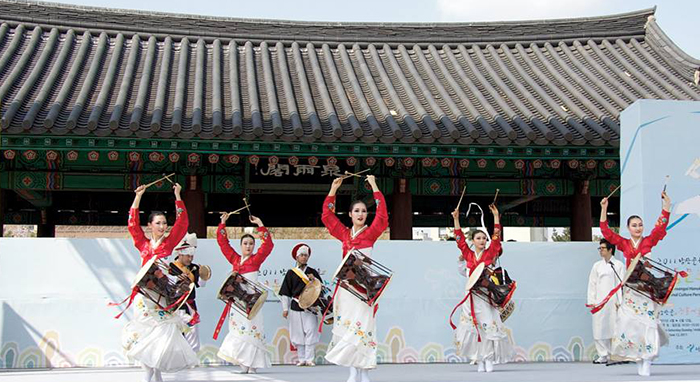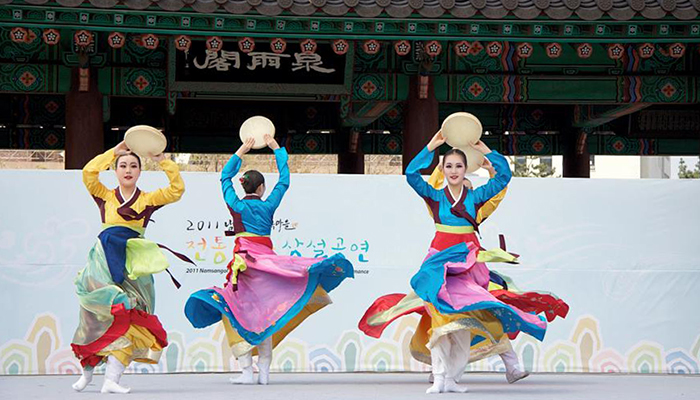I want to share some korean slang to you. ENJOY ! ^^
아싸 (ahssa) – Awesome
짱 (jjang) – Cool
당근 (danggeun) – Of course. Literally means ‘carrot’.
돌대가리 (doldaegari) – Retard, moron [stronger than 바보 (babo)]
차다 (chada) – To dump a boyfriend or girlfriend
번개[팅] (bongaeting) – To meet someone (in real life) that you first got to know over the internet
변태 (byeontae) – A pervert
공부벌레 (gongbu beolle); 책벌레 (chaek beolle); 독서광 (dokseogwang) – A bookworm
붕어빵 (bongeopang) – Used to tell a person they look like someone else. Also the name of red bean paste-filled pastries that resemble a carp.
돌아이 (dolai) – Crazy person
존나 (jonna) – Fucking/Very. Example, “존나춥다 [jonna ! It's fucking cold!]”
죽을래? (jugeullae?) – Wanna die?
콩다방 (kong dabang) – The Coffee Bean
별다방 (byeol dabang) – Starbucks
얼짱(eol jjang) – ‘Best’ looking [as opposed to just 'good' looking]. The most beautiful/handsome person in a given group
쌩얼 (ssaeng eol) – Face without makeup/bare face
디카 (dika) – Digital Camera
플스 (peulseu) – Play Station
여친 (yeochin)- Girlfriend [from 여자친구 (yeoja chingu)]
남친 (namchin) – Boyfriend [from 남자친구 (namja chingu)] -both in the ‘relationships’ list.
음치 (eumchi) – Tone-deaf/bad singer
멋져 (meotjyeo) – Sweet!
닥쳐! (dakchyeo!) – Shut up!
킹카 (kingka) - Hot guy
괸카 (gwinka) – Hot girl
허당 (heodang) – Someone who is easily confused
완소 (wansu) – Completely precious, from 완전 소중한 (wanjeon sojunghan), which literally translates to ‘fully valued’
쌈 싸 먹어! (ssam ssa meokgeo!) - I think it’s something like “Take it and shove it!”
대박 (daebak) – Someone who’s awesome. Example, “대박이다 (daebakida)!” which means “You’re the best!”
꼬맹이 (kuimaengi) – Kids from toddler’s age to early school years
학교통 (hakgyotong) – School rebel or the kid who doesn’t listen to the teachers, picks fights a lot, etc.
양 아치 (yang ahchi) – Kids who think they are too c00l for sch00l; kids who pick fights, never study, argue with the teacher, chew chewing gum in class, etc.
모범생 (mobeomsaeng) – Opposite of a 양아치. A kid who’s really good in school.
싸 가지 (ssa gaji)– I don’t actually know what this meaning exactly but it has the feeling of like “retard, idiot, loser”. It’s kind of harsher than those words as well.
꼴등 (koldeung) – Dead last
길치 (gilchi) – A person who is hopeless with directions
몸치 (momchi) – A person who can’t dance
몸짱 (momjjang) – A person with a good (muscular/toned) body
바람둥이 (baram dungi) – Flirt/player. A guy who dates all the girls.
간지교 (ganjigyo) – A cool/stylish guy.
지못미 (jimonmi) – From “지켜주지 못해서 미안해요 (jikajuji mothaeseo mianhaeyo)”, which means “sorry I couldn’t protect you”. This is said to people/celebrities when they turn out really bad in a photo
열공! (yeol gong) – From “열심히 공부해요 (yeolshimhi gongbuhaeyo), which means“study hard!”
넘 (neom) – Too/So. Short for 너무 (nomu).
Korean Slang
Korean Traditional Music (Gugak)

While court music includes ritual and aristocratic music like aak (imported from China), dang-ak (a fusion between Chinese and Korean court music) and hyang-ak (purely Korean), the folk music has p’ansori (vocal), sanjo (instrumental music), jeong-ak (instrumental and vocal music), nongak (“farmers’ music”, drumming, dancing, and singing), shinawi (shamanistic music) and salpuri (dance, related to shaman rituals). Today, we also have newer additions to Korean Music, Changjak-gugak or Shin-gugak, newly-composed Korean traditional music and fusion gugak, with western elements.
I would like to give you a general overview of Korean Traditional Music and focus on two interesting topics, P’ansori and Fusion Gugak afterwards.
Popular instruments in Korean Traditional music are the plucked zither gayageum, fiddle haegeum, bamboo flute daegeum, hourglass-shaped drum janggu, which is the most prominent rhythm instrument in Korean music. Inspired by the western orchestra, there are also orchestra like formations with traditional instruments in Korea, including a conductor.
Rhythm and TheoryOne unique aspect of Korean folk music you will come across, is the freedom a master musician possesses during the performance.Improvisation during a concert, be it as soloist or ensemble, is allowed and depend on the personal preference of the musicians. The basic rhythm in folk music are called jangdan (can also mean tempo, accent) and while they follow set patterns, it is expected that a skilled artist is able to improvise individually, using the patterns as foundation.

Previously the songs of one p’ansori were performed throughout the whole day or only pieces of it, as entertainment for a banquet or celebration for passing a government exam, but at the present day people expect a p’ansori performance by a master singer to be complete, hence performances can last between three to eight hours (with small breaks of course).
The five P’ansoriChunhyangga is a romantic love story about a woman, who endures hardships and stays faithful until her lover returns. Their relationship is not an usual one, as she is the daughter of a gisaeng (female entertainer) and he is of noble birth. This famous story was retold in movies for the cinema and also in a modernized TV Series, Sassy Girl Chun Hyang.
To regain his sight, the father promises a wandering monk hundred sacks of rice but because he is as poor as a beggar and can’t fulfill his promise to the monk, his daughter Simcheong sells herself to fishermen who are in need for a sacrifice for the water god.
While the poor, younger brother is rewarded with riches for his honest life after he mends the broken leg of a swallow, the older brother who inherited the family fortune falls into disgrace after he purposely breaks the leg of a swallow to gain the same riches as his younger brother.
National Theater of Korea (http://www.ntok.go.kr/english/)
Highly popular are musicals like Miso, with a storyline from Korean folklore and a combination of korean and western music and formations like SOREA, a girl group-esque ensemble, comprised of players of the gayageum, haegeum, daegeum, kkwaenggwari (small, flat gong), janggu, who speak to a younger audience in and outside of Korea with their rigorously choreographed performances and attractive looks.
Soundtracks of Korean TV Dramas (OST), often include Fusion Gugak and official institutions, such as the KTO (Korea Tourism Organization) use the music of Fusion Gugak to introduce Korea to foreigners.
About Hanbok
| Hanbok is the traditional attire of Korea. Its history dates back as far as the Three Kingdoms Period (57 B.C. – 668 A.D.). Koreans weaved cloth with hemp and arrowroot and raised silkworms to produce silk. It is divided largely into daywear and ceremonial wear, with differences between age, gender, and season.
The women's hanbok is comprised of a wrap-around skirt and a jacket. It is often called chima-jeogori, 'chima' being the Korean word for skirt and 'jeogori' the word for jacket. The men's hanbok consists of a short jacket and pants, called 'baji', that are roomy and bound at the ankles. Both ensembles may be topped by a long coat of a similar cut called 'durumagi'.
The Hanbok, worn today are patterned after those worn during the Confucian-oriented Joseon Dynasty (1392-1910). The Yangban, a hereditary aristocratic class based on scholarship and official position rather than on wealth, wore brightly colored hanbok of plain and patterned silk in cold weather and closely woven ramie cloth or other high-grade, light weight materials in warm weather. Commoners, on the other hand, were restricted by law as well as finances to bleach hemp and cotton, and could only wear white, pale pink, light green, gray or charcoal colors. | ||
| Royal Clothes | |||||||||||
The early Joseon Dynasty kings made neo-Confucianism the ruling ideology. Its emphasis on formality and etiquette dictated the style of dress for the royal family, aristocrats, and commoners for all types of occasions including weddings, and funerals. Integrity in men and chastity in women became the foremost social values and was reflected in the way people dressed.
| |||||||||||
| Kinds of Hanbok | ||
The various kinds of the hanbok are classified according to the social status, class, gender, and age of those who wear them. Today, the hanbok is worn mostly on special occasions, and is divided into categories based on its function. These include, but are not limited to, weddings, 61st birthdays, first birthdays and holidays. Myeongeol Hanbok Myeongeol HanbokKoreans traditionally show their respect to their parents early in the morning on the first day of the New Year by bowing deeply. Customarily, both parents and children wore hanbok. Children's hanbok usually consists of a rainbow-striped jeogori (jacket) and either a chima (girls' skirt) or a baji (boys' pants).  Dol Hanbok Dol HanbokThe first birthday of a child, the dol, is traditionally celebrated with wishes for longevity and health. Children wear the dol-hanbok or dol-ot on this special day. A boy usually wears a pinkish jeogori (jacket) with a long blue goreum (cloth strings). Girls usually wear a rainbow-striped jeogori for special occasions. Currently, the trend is for girls to war a dangui, a kind of ceremonial coat.  Hoegabyeon Hanbok / Gwanryebok Hoegabyeon Hanbok / GwanryebokHoegabyeon is when children throw a party to celebrate the 61st birthday of either parent and wish for their longevity. Men who turn 61 wear a geumgwanjobok, while women wear a dangui, a kind of ceremonial dress for special occasio  Hollyebok (Wedding Hanbok) Hollyebok (Wedding Hanbok)Unlike hanboks for daily use, hanboks worn as a traditional wedding costume is marked by its bright appearance. The bridegroom wears the baji (pants), the jeogori (a jacket), the joggi (a vest), the magoja (an overcoat), and the durumagi (an overall coat). The bride wears a green chima (a skirt), a yellow jeogori (a short jacket), and a wonsam (a bride's long overcoat). Her hair is prepared using a jokduri (a special head ornament). .jpg) Saenghwal Hanbok Saenghwal HanbokThe use of rational hanboks follows complex rules, and requires meticulous attention. Because of this, a simplified version of the hanbok has been introduced for daily use which incorporates simplicity and convenience. An increasing number of people want to express their individuality by wearing something that combines traditional beauty and modern simplicity. The modern version comes in a wide variety of styles and fabrics. > For more information on the evolution of Hanbok, click here. | ||
Must Visit Place in South Korea !
1. Myeondong
Myeong-dong is Seoul’s shopping mecca and is a must-see for tourists, but it is not just a shopping destination; Myeong-dong is also a center of commerce, banking and culture with a daytime population of 1.5-2 million. For shoppers there is a mixture of street stalls and retail outlets selling everything from high fashion to casual attire as well as many Korean cosmetics stores offering high-quality products at competitive prices ! Myeong-dong is full of beauty outlets. For people who love mall shopping and following the latest trends, Myeong-dong has it all.
Myeong-dong’s street stalls are a real tourist attraction selling all kinds of items including belts, watches, ties and T-shirts. There are also street food stalls serving traditional Korea delicacies such as fish cakes, tteokbokki (a stir-fried dish made of rice cakes with vegetables in hot sauce) and soondae (steamed pig’s intestines stuffed with bean curd, soy bean sprouts, green onions, starch noodles and mushrooms).
Myeong-dong also has Korea’s first Catholic church, Myeongdong Catholic Cathedral offering peace and tranquility to weary shoppers who want a rest from consumer culture. Nearby Namsan Park is also well worth a visit.
| Inside COEX |
| COEX Aquarium |










